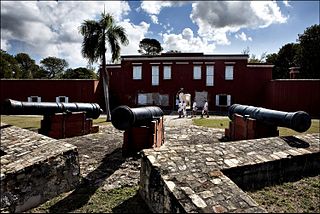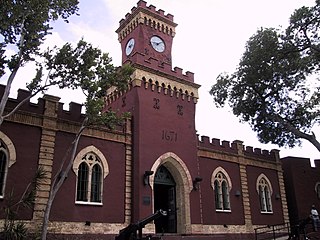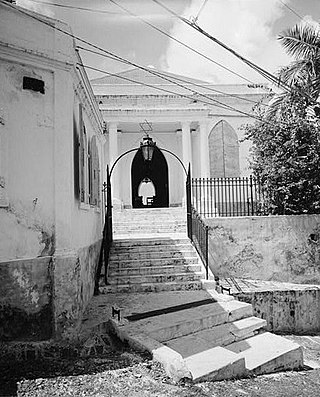| Formation | 1966 |
|---|---|
| Type | Non-profit historic preservation organization |
| Purpose | To preserve the cultural and historical heritage of Saint Thomas, through education, advocacy, and preservation promotion |
| Headquarters | 5332 Raadets Gade, Charlotte Amalie, St Thomas, VI 00802 |
| Location |
|
| Website | Official Saint Thomas Historical Trust website |
St Thomas Historical Trust (also Saint Thomas Historical Trust), is a non-profit historic preservation organization located on Saint Thomas island, in the United States Virgin Islands.
The Trust's headquarters and history museum are located at 5332 Raadets Gade (Council's Street) of Charlotte Amalie on St. Thomas. [1] The Trust works to preserve the cultural and historical heritage of Saint Thomas, through education, advocacy, and preservation promotion.
It has an ongoing program of historical and cultural events, including lectures, walking tours, practical projects and activities for children. [2] It also organises initiatives to celebrate traditions of the islanders and raises funds for future preservation work. [3]
The Trust was established in 1966 as a non-profit organization. Early projects included involvement in the archeological site on Tutu island. [4]
The Trust has since been involved in numerous preservation, restoration, and outreach projects, including the Hassel Island Historic District on Hassel Island, the Bred Gade step streets of Charlotte Amalie, and the Danish colonial Fort Christian. [1] [5] [6]

The United States Virgin Islands are a group of several dozen islands and cays located in the Caribbean, about 1,100 miles (1,770 km) southeast of Florida, 600 miles (966 km) north of Venezuela, 40 miles (64 km) east of Puerto Rico, and immediately west and south of the British Virgin Islands.

Charlotte Amalie, located on St. Thomas, is the capital and the largest town of the United States Virgin Islands. It is the anchor of the subdistrict of Charlotte Amalie that is composed of the town of Charlotte Amalie, the census-designated place (CDP) of Charlotte Amalie West, and the CDP of Charlotte Amalie East. It was founded in 1666 as Taphus. In 1691, the town was renamed to Charlotte Amalie after the Danish queen Charlotte Amalie of Hesse-Kassel (1650–1714). It has a deep-water harbor that was once a haven for pirates and is now one of the busiest ports of call for cruise ships in the Caribbean, with about 1.5 million-plus cruise ship passengers landing there annually. Protected by Hassel Island, the harbor has docking and fueling facilities, machine shops, and shipyards and was a U.S. submarine base until 1966. The town has been inhabited for centuries. When Christopher Columbus arrived in 1493, the area was inhabited by Caribs, Arawaks, Ciboney and Taíno native peoples. It is on the southern shore at the head of Saint Thomas Harbor. In 2020 the subdistrict of Charlotte Amalie had a population of 14,477 which makes it the most densly populated area in the Virgin Islands Archipelago with the town of Charlotte Amalie as the anchor of "the City". Hundreds of ferries and yachts pass by the town each week.

Saint Thomas is one of the Virgin Islands in the Caribbean Sea, and a constituent district of the United States Virgin Islands (USVI), an unincorporated territory of the United States. Along with surrounding minor islands, it is one of three county-equivalents in the USVI. Together with Saint John, it forms one of the districts of the USVI. The territorial capital and port of Charlotte Amalie is located on the island.

The Virgin Islands National Park is a national park of the United States preserving about 60% of the land area of Saint John, U.S. Virgin Islands, as well as more than 5,500 acres of adjacent ocean, and nearly all of Hassel Island, just off the Charlotte Amalie, Saint Thomas harbor.

Frederiksted is both a town and one of the two administrative districts of St. Croix, U.S. Virgin Islands. It is a grid-planned city, designed by surveyor Jens Beckfor, originally to 14x14 blocks but built 7x7 to enhance the island commerce in the 1700s. Fewer than 1,000 people live in Frederiksted proper, but nearly 10,000 live on the greater western side of the island. Christiansted is about 30 years older, but commerce was limited by its natural, shallow protective reef. Frederiksted was built in the leeward side of the island for calm seas and a naturally deep port. It is home to Fort Frederik, constructed to protect the town from pirate raids and attacks from rival imperialist nations and named after Frederick V of Denmark, who purchased the Danish West Indies in 1754.
Water Island is a minor island in the United States Virgin Islands, an American territory located in the Caribbean Sea. The rest of the U.S. Virgin Islands were acquired by the Americans in 1917 from Denmark; however, Water Island was excluded, thus the Danish East Asiatic Company, and by proxy the Danish kingdom, continued to own Water Island until several decades later. Water Island was bought by the U.S. Government in 1944, and in 1996 it was transferred to the U.S. Virgin Islands. The island is of volcanic origin and lies to the south of Saint Thomas in the Charlotte Amalie harbor. A ferry service runs regularly from Crown Bay, Saint Thomas, to Phillips Landing, Water Island; the ferry ride is about 10 minutes.

Hassel Island is a small island of the U.S. Virgin Islands, a United States territory located in the Caribbean Sea. Hassel Island lies in the Charlotte Amalie harbor just south of Saint Thomas and east of Water Island, with which it is part of the sub-district of Water Island.

Anna's Retreat is a town in the administrative subdistrict of Tutu in St. Thomas, U.S. Virgin Islands. As of 2006, the population was 7,600, making Anna's Retreat the second-largest town in the U.S. Virgin Islands after the territorial capital, Charlotte Amalie.

Fort Christian is a Dano-Norwegian-built fort in Charlotte Amalie, Saint Thomas, U.S. Virgin Islands. Built 1672-1680, early in the first successful colonial establishment on the island, the fort served as a critical point of defense and government during the entire period of Dano-Norwegian, and later Danish, administration, which ended in 1917 with the sale of the islands to the United States. It currently holds the St. Thomas Museum, which holds artifacts and art of the Dano-Norwegian period. It was designated a U.S. National Historic Landmark in 1977.

Charlotte Amalie High School (CAHS) is a public high school housing a population of just over 1400 students, and over 130 members of faculty and staff. It is located in what is colloquially called the "town area" of the island of St. Thomas, United States Virgin Islands. It is named after the official name for the "town area," Charlotte Amalie. It is a part of the St. Thomas-St. John School District. It is the territory's most populous high school.

Highway 30 is a major road on St. Thomas, USVI.

The following is an alphabetical list of articles related to the territory of the United States Virgin Islands.

St. Thomas Synagogue, officially Congregation Beracha Veshalom Vegmiluth Hasadim or The Hebrew Congregation of St. Thomas, is a historic Reform Jewish synagogue located at 2116 Crystal Gade, Queens Quarters, in Charlotte Amalie on the island of Saint Thomas in the U.S. Virgin Islands. The synagogue building was declared a National Historic Landmark in 1997.

Tutu, also known as Estate Tutu is one of the seven administrative subdistricts on Saint Thomas island in the United States Virgin Islands. It is located in eastern St. Thomas and is mostly made up of the second-largest town in the U.S.V.I., Anna's Retreat in the Tutu Valley, sometimes nicknamed Tutu. The word tutu, in Danish, means a trumpet-like conch shell which was used to call the slaves to work. According to the U.S. Census Bureau in 2010 the population was 6,867, which is down from 8,197 in 2000 and further down from 9,100 in the U.S. Census of 1990. Tutu is known as a densely populated residential area and is second only to the territorial capital of Charlotte Amalie in terms of highest population density on the island of Saint Thomas. It is home to approximately 20 percent of the island population and has a total area of 1.5 square miles. There have been numerous excavations in an area known as the Tutu Archaeological Village Site, which has discovered numerous artifacts from the native Arawak people who inhabited the area in the pre-Columbian era.

The Creque Marine Railway, formerly the "St Thomas Marine Repair Facility", is an inclined-plane ship railway on Hassel Island, in the bay of Charlotte Amalie off the coast of St. Thomas Island, in the U.S. Virgin Islands. Its site is below Fort Shipley, within Virgin Islands National Park.

The Charlotte Amalie Historic District in Charlotte Amalie in Saint Thomas, U.S. Virgin Islands is a 165.3 acres (0.669 km2) historic district which was listed on the National Register of Historic Places in 1976.

Edith L. Williams was a United States Virgin Islands educator, women's rights activist, and suffragist. Williams was the first woman who attempted to vote in the Virgin Islands and when she was denied the right to register, she petitioned the court along with Eulalie Stevens and Anna M. Vessup to review their qualifications. They won their case and subsequently women throughout the Virgin Islands who were literate and property owners were allowed to vote. A bust of Williams was installed in the Franklin Delano Roosevelt Veterans Memorial Park in Charlotte Amalie, and the James Madison Elementary School was renamed as the Edith L. Williams School in 1981 in her honor.

Fort Willoughby is a historic fort on Hassel Island in the U.S. Virgin Islands.

13 Wimmelskafts is a former slave quarters located in Charlotte Amalie, the capital of The United States Virgin Islands. The town was established by The Danish West Indian Company in 1671 with the approval of King Christian V of Denmark. Today the town of Charlotte Amalie is a national historic landmark.